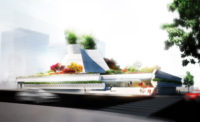In the heart of the Thar Desert in the Indian state of Rajasthan, New York–based architect Diana Kellogg has built Rajkumari Ratnavati Girls School for the city of Jaisalmer. A pro-bono project for Kellogg commissioned by New York–based non-profit group CITTA, the school will serve more than 400 girls from households below the poverty line in the region where female literacy is just 36 percent. Given India’s current surge in Covid cases and lockdowns, it is meant to open in July.
An oval-shaped structure with a paved central courtyard, the nearly 9,000-square-foot school was constructed by local craftsmen—many of the girls’ fathers—with hand-carved Jaisalmer sandstone sourced from the area.
“Stone was so abundant and the craftsmen so skilled, it was really the only option,” Kellogg tells RECORD of the material. “When I asked about different design ideas they smiled and proudly said, ‘We can do anything in stone.’”
Kellogg’s design team focused on sustainable elements, given the harsh desert environment, and oriented the ellipse-shaped building to filter out sunlight, maximize air flow and wind throughout the series of 10 classrooms and computer center, while also utilizing a passive solar cooling strategy. The team also followed ancient regional water harvesting techniques to help the school harness precious rainwater, and created a rooftop solar canopy with a metal framework that powers the interior lighting and fans but can double as a jungle gym for the children.
“Since the building was built for a non-profit to support girls’ education, every effort was made toward economic design,” said Kellogg in a statement. “I knew I wanted to do a building that simultaneously blended and grew out of the natural landscape, much like the Jaisalmer sandstone,” she tells RECORD. “I was also committed to sustainability and using the stone in a modernized way to bring attention to the craftsman in the area.”
Inside, the school is furnished with pieces made from local rosewood and Charpai woven seating, a traditional bed technique used across South Asia. In addition to the culturally conscious architecture, Indian fashion designer Sabyasachi Mukherjee designed uniforms for the girls using Ajrak, a form of block printing native to the region.
The newly-completed structure is to be part of a larger complex called the GYAAN Center, which will include an exhibition space called the Medha and the Women’s Cooperative building, where local artisans will teach women traditional handcraft techniques.
Video by Vinay Panjwani











Post a comment to this article
Report Abusive Comment